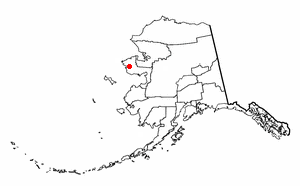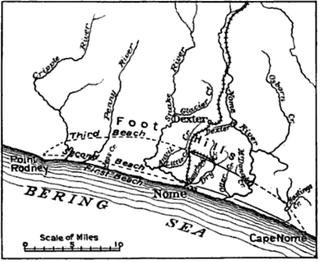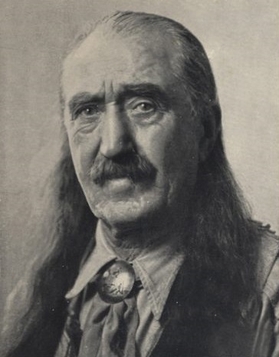
Nome is a city in the Nome Census Area in the Unorganized Borough of Alaska, United States. The city is located on the southern Seward Peninsula coast on Norton Sound of the Bering Sea. It had a population of 3,699 recorded in the 2020 census, up from 3,598 in 2010. Nome was incorporated on April 9, 1901, and was once the most-populous city in Alaska. Nome lies within the region of the Bering Straits Native Corporation, which is headquartered in Nome.

The Iditarod Trail Sled Dog Race, more commonly known as The Iditarod, is an annual long-distance sled dog race run in early March. It travels from Anchorage to Nome, entirely within the US state of Alaska. Mushers and a team of between 12 and 14 dogs, of which at least 5 must be on the towline at the finish line, cover the distance in 8–15 days or more. The Iditarod began in 1973 as an event to test the best sled dog mushers and teams but evolved into today's highly competitive race.

John Franklin Alexander Strong was a Canadian-born journalist who was the second governor of Alaska Territory from 1913 to 1918.

Mary's Igloo is an abandoned village located in the Nome Census Area of the Unorganized Borough in the U.S. state of Alaska, now used as a fish camp. Many former residents and their descendants currently live in nearby Teller or the next largest community, Nome.

Ada Blackjack was an Iñupiat woman who lived for two years as a castaway on the uninhabited Wrangel Island, north of Siberia.

Jafet Lindeberg was a gold prospector and co-founder of the city of Nome, Alaska.

Jujiro Wada was a Japanese adventurer and entrepreneur who achieved fame for his exploits in turn-of-the-20th-century Alaska and Yukon Territory.

The Nome mining district, also known as the Cape Nome mining district, is a gold mining district in the U.S. state of Alaska. It was discovered in 1898 when Erik Lindblom, Jafet Lindeberg and John Brynteson, the "Three Lucky Swedes", found placer gold deposits on Anvil Creek and on the Snake River few miles from the future site of Nome. Word of the strike caused a major gold rush to Nome in the spring of 1899.

The Church of Jesus Christ of Latter-day Saints in Alaska refers to the Church of Jesus Christ of Latter-day Saints and its members in Alaska. The first congregation of the Church in Alaska was organized in 1938. It has since grown to 33,574 members in 81 congregations.

The Thomas Corwin was a United States revenue cutter and subsequently a merchant vessel. These two very different roles both centered on Alaska and the Bering Sea. In 1912, Frank Willard Kimball wrote: "The Corwin has probably had a more varied and interesting career than any other vessel which plies the Alaskan waters."

Erik Lindblom (1857-1928) was a Swedish-American gold prospector. He was one of the "Three Lucky Swedes" who founded and developed the Nome mining district.
John Brynteson was one of the "Three Lucky Swedes" who founded and developed the Nome mining district.

Cape Nome is a headland on the Seward Peninsula in the U.S. state of Alaska. It is situated on the northern shore of Norton Sound, 15 miles (24 km) to the east of Nome also on Norton Sound. It is delimited by the Norton Sound to the south, Hastings Creek on the west, a lagoon on the east and an estuary formed by the Flambeau River and the Eldorado River. From the sea shore, Cape Nome extends inland by about 4 miles (6.4 km), connected by road with Nome.
Crystal Brilliant Snow Jenne was the first woman to run for the Alaska Territorial House of Representatives in the Alaska Territory.

The Nome Gold Rush was a gold rush in Nome, Alaska, approximately 1899–1909. It is separated from other gold rushes by the ease with which gold could be obtained. Much of the gold was lying in the beach sand of the landing place and could be recovered without any need for a claim. Nome was a sea port without a harbor, and the biggest town in Alaska.
Fred Lockley was an American journalist best known for his editorial column for the Oregon Journal, "Impressions and Observations of a Journal Man", which appeared throughout the Western United States on a nearly daily basis. Lockley also authored many books which, like his articles, were largely about his travels and interviews with early settlers in the Willamette Valley. It was said that he interviewed "bullwhackers, muleskinners, pioneers, prospectors, 49ers, Indian fighters, trappers, ex-barkeepers, authors, preachers, poets and near-poets". He also interviewed Thomas Edison, Booker T. Washington, Ezra Meeker, Woodrow Wilson, Count Tolstoy, General Hugh Scott, Harry Houdini, and Jack London.
Émilie Tremblay was one of the first white women to cross the Chilkoot on the way to the Yukon gold fields. She was French-Canadian and the founder, and first president, of the Society of the Ladies of the Golden North. She was also president of the Yukon Order of Pioneers Auxiliary. A businesswoman, she owned and operated a store in the Yukon in what is now a heritage building.

George Valdemar Borchsenius was an American attorney. He was the first clerk of the court of the Nome judicial division of Alaska.
The history of the Jews in Alaska began before the Alaska Purchase in 1867. Jews from Imperial Russia lived there periodically as fur traders, and a Jewish community has existed since the 1880s. The Klondike and Nome gold rushes attracted Jews to Alaska to seek their fortunes as miners and businessmen and resulted in the first organized Jewish communities. In the Nazi period, Jewish refugee resettlement in Alaska was seriously considered by the government, but after facing backlash, never came to be. Alaskan Jews played a significant role in business and politics before and after statehood, and have included mayors, judges, senators and governors. Today, there are Jews living in every urban area of the state.

Julius Mortimer "Bronc(h)o Charlie" Miller was an American horse tamer and Pony Express rider. He was born on the trail in California to parents travelling west for the California Gold Rush. At the age of 11 Miller claimed to have become the youngest ever Pony Express rider, claiming to have done so after witnessing a horse arrive without its rider at the station in Sacramento. Miller then worked as a horse trainer, from which he earnt his nickname, including a period working on Teddy Roosevelt's cattle ranch. Afterwards he became a performer demonstrating roping techniques, horse riding and knife throwing. On his travels he met and married Carrie Potter, who joined and became a target girl in his act.














